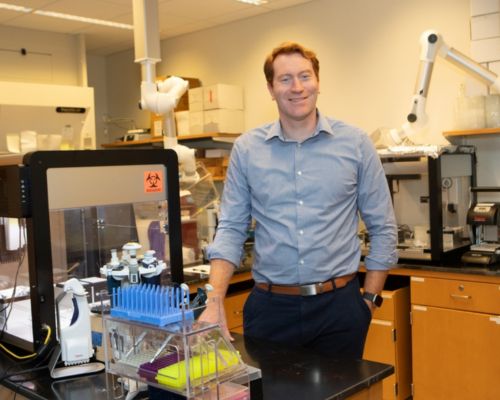How do researchers study the role of multiple chemical exposures in breast cancer risk?
This blog is the second in a series about a new study that looks at how a woman’s exposure to chemical mixtures may increase the risk of breast cancer. (Read the first article here.) The study also explores whether women from different economic backgrounds experience different levels of chemical exposure.
This study is led by Dr. Kimberly Badal from the University of California, San Francisco, with help from Dr. Douglas Walker from Emory University and other researchers. It aims to find out which individual chemicals and mixtures are linked to breast cancer. It will give insight into how we can reduce exposure to chemicals to lower the risk of getting breast cancer. We interviewed Dr. Walker about non-targeted analysis, the method he brings to the study that will enable these complex research questions to be answered.
What is Non-Targeted Analysis?
Most studies that look at chemicals in the environment focus on testing a single or just a few known chemicals at a time. However, we are exposed to many more unknown chemicals in our daily lives. Non-targeted analysis allows researchers to look at many chemicals all at once.
Non-targeted analysis is like taking a "snapshot" of all the different chemicals in a human blood sample without singling out any specific chemicals beforehand. It is similar to how a detective might scan a crime scene for clues without knowing exactly what they're searching for. This method helps scientists discover links between chemicals and health conditions, including breast cancer, even ones that they weren’t expecting.
When conducting non-targeted analysis, scientists collect and prepare the blood sample, then use advanced tools like mass spectrometry to break the blood down to all its components in order to detect them. Mass spectrometry is a technique used to identify and analyze substances by measuring the "weight" of their molecules, essentially by turning them into charged particles and then sorting them based on how heavy they are. This allows scientists to determine what a substance is made of and how much of each component is present, similar to how you might separate different sized marbles by rolling them down a ramp with different inclines. The instruments generate data that is processed and analyzed with specialized software to identify what’s in the sample. Scientists compare this data with known databases to find matches and figure out what substances are present. This method helps reveal unexpected or unknown compounds in complex mixtures.
By analyzing this data, Dr. Walker and his team can discover new links between these exposures and breast cancer, which can provide a more complete understanding of potential risks.
“There are so many different things that we're exposed to, we don't know which ones we should be focusing on or measuring specifically to see which people who have higher exposures have a higher risk of developing breast cancer,” Dr. Walker said. “And so what the non-targeted methods allow us to do is say, ‘Okay, let's measure as many different pollutants or toxicants that we can find in this population, and then we'll test to see if any of those are associated with increased risk of breast cancer.’”
How the Study Works
Dr. Walker’s team will use blood samples from women who have had breast cancer and women who have not, all taken from the Athena Breast Health Network. Athena is a unique collaboration among the five University of California medical centers that has been following thousands of women being screened for breast cancer over several decades.
The researchers will use non-targeted analysis to find as many chemicals and metabolites — the body’s chemical compounds — as possible. After looking at the data, Dr. Badal will compare how chemicals and metabolites and their amounts are different between the women who developed breast cancer and those who did not. The team is looking at whether the chemicals and metabolites are present and how many of them there are. By studying how these metabolites change, scientists can better understand the risk of diseases like breast cancer.
The study also aims to find out how chemical exposures affect different groups of people. Instead of just looking at factors such as a person’s neighborhood or income and considering likely exposures, as has been done in the past, the researchers will focus on the actual biological changes caused by these exposures.
What’s Next?
If successful, the results of this study will help scientists better understand the connection between chemical exposures and health and guide future research. Dr. Walker emphasized that further studies across diverse groups will be necessary to strengthen and confirm research in this area.
Ultimately, the goal of this kind of research is to use these findings to help improve or maintain people’s health. Right now, doctors use blood tests to check for certain health problems, like diabetes or cholesterol levels. In the future, doctors may also test for chemical exposures, which could help identify health risks. Based on the results, doctors might suggest ways to reduce exposure to harmful chemicals, such as avoiding certain products or changing aspects of the environment, like using air filters.
“We're really hoping that this is just the beginning,” Dr. Walker said. “There will be many instances where we need to expand this beyond certain populations [groups] and really look holistically across different populations [groups] to see if these are still risk factors.”
Blog Writer: Rhea Patney, CHE Science Communications Intern
Interviewers: Bridget Martin, MD, CHE Science Communications Intern; Lianna Hartmour, MA, NBC-HWC, ZBC Program & Communications Director


